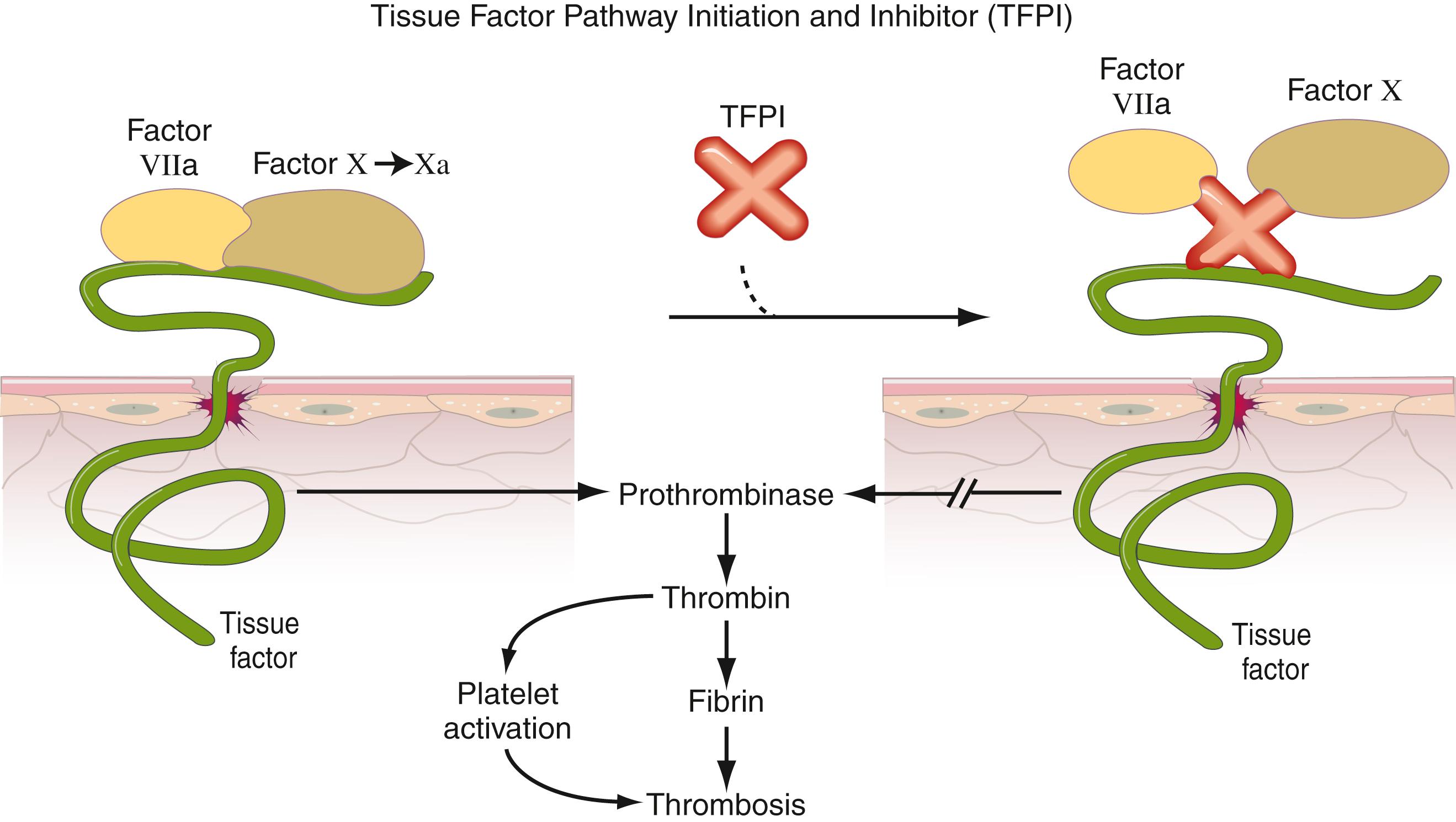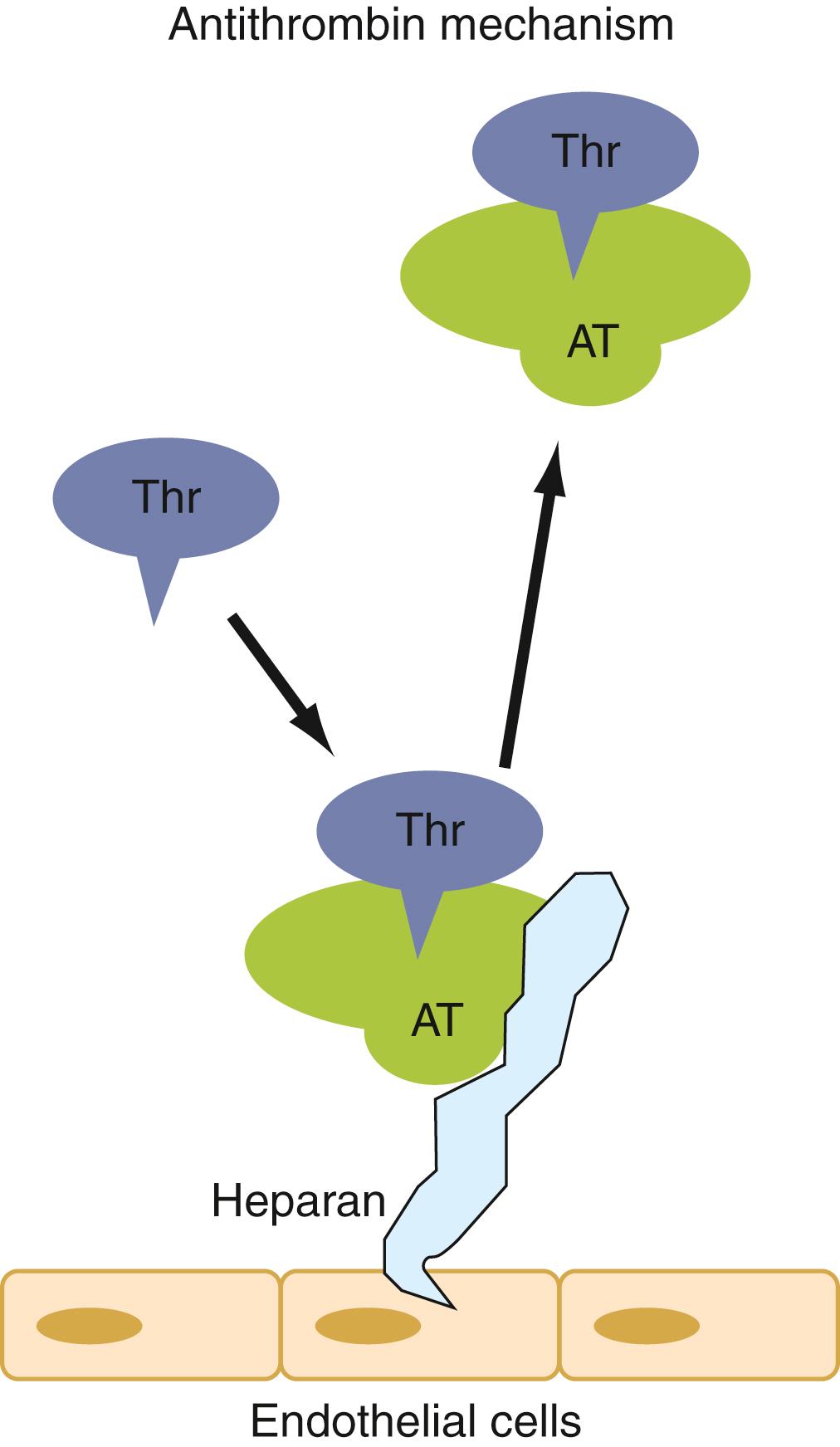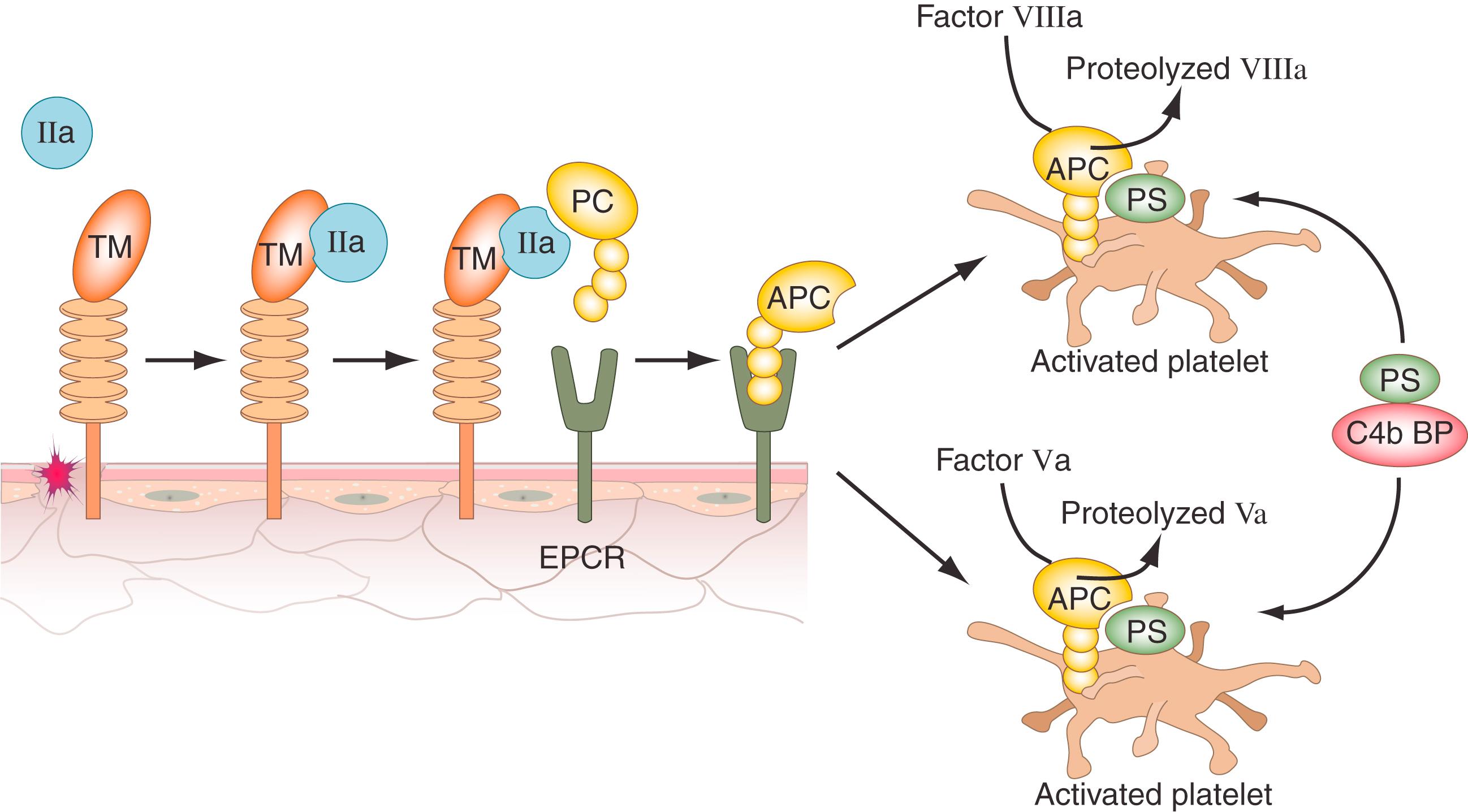Physical Address
304 North Cardinal St.
Dorchester Center, MA 02124
Several regulatory mechanisms have evolved to limit the extent of clot formation after coagulation is triggered. Under normal conditions, these allow hemostasis to be achieved while preventing the growth of a hemostatic plug into an intravascular thrombus. Among these regulatory systems are the antithrombin mechanism, the protein C–protein S system, the fibrinolytic system, and the tissue factor pathway inhibitor mechanism.
Deficiencies of the major regulatory proteins (antithrombin, protein C, and protein S) increase the risk for venous thrombosis. Increased levels of procoagulant factors and variants of the genes for coagulation factors V and prothrombin—specifically, factor V Leiden and prothrombin g20210a—also increase the risk for venous thrombosis.
The factor V Leiden variant results in resistance to activated protein C (APC) by reducing the susceptibility of factor Va to proteolysis by APC. The prothrombin G20210A variant is associated with increased levels of prothrombin due to a promoter polymorphism, a base pair substitution at 20210.
Inherited or acquired dysfibrinogenemias and defective fibrinolysis may also increase the risk of venous thrombosis.
The autoimmune disorder antiphospholipid syndrome (APS) increases the risk of both venous and arterial thrombosis, thrombotic microangiopathy, and pregnancy complications attributable to a reduction in placental perfusion. APS is detected with immunoassays for antiphospholipid antibodies and coagulation assays, known as lupus anticoagulants, that report inhibition of phospholipid-dependent coagulation reactions in vitro but not in vivo. There is accumulating evidence for the role of complement in APS, particularly for the catastrophic form of the disorder.
When evaluating a patient for thrombotic risk, it is important to decide whether diagnostic testing is appropriate, to understand the clinical significance of the assays, and to appropriately plan the timing of testing. Recent thrombotic events, anticoagulant therapy, normal pregnancy, and acute-phase reactions can all affect the levels of these endogenous anticoagulant factors.
The authors thank Drs. Richard Marlar, Louis Fink, Jonathan Miller, and John Mitsios for their contributions as authors of this chapter in the prior editions of this textbook.
Following vascular injury, hemostatic regulatory mechanisms limit the amount, location, and duration of clot formation to effectively seal blood vessels at sites of injury while preventing the initiation of hemostasis from extending into occlusive thrombosis. Dysfunction in these regulatory systems may lead to the pathologic condition of excessive clot formation (thrombosis). Both genetic and acquired deficiencies and abnormalities of such regulatory factors are capable of increasing the risk for thromboembolism. This chapter discusses a number of factors that influence the balance toward bleeding or toward thrombosis, as well as the role of the laboratory in identifying abnormalities associated with these factors.
The endogenous anticoagulants play a key role in maintaining a balance between an adequate hemostatic response to injury that would result in bleeding and an excessive response that would lead to thrombosis and tissue damage. (For a schematic overview of physiologic anticoagulant pathways, see Fig. 40.5 in Chapter 40 .) An inhibitory mechanism has been identified for virtually each step of the coagulation system, as follows.
Tissue factor (TF), a major initiator of coagulation, is inhibited by the protein tissue factor pathway inhibitor (TFPI, or TFPI-1).
The phospholipid membrane surface that is required for the assembly of coagulation enzyme-substrate complexes becomes shielded by the binding of annexin A5 and its subsequent two-dimensional crystallization.
The catalytic sites of the activated coagulation enzymes are neutralized by the serpin antithrombin.
The prothrombotic enzymatic specificities of thrombin—that is, cleavage of fibrinogen, activation of factors V, VIII, XI, and XIII, and activation of platelets—are lost when it binds to thrombomodulin and it develops specificity for activating protein C.
Following their activation by thrombin, factors Va and VIIIa are proteolyzed by activated protein C, which was itself activated by thrombin bound to thrombomodulin.
Formed fibrin is degraded by the fibrinolytic system.
Coagulation is triggered by the exposure of circulating blood to membrane-bound tissue factor (TF), which, in turn, complexes with factor VII/VIIa to initiate coagulation. The protein named tissue factor pathway inhibitor ( TFPI , or TFPI-1 ; Fig. 42.1 ) limits the activity of the TF-VII/VIIa complex ( ; ; ). This is accomplished through its two reactive binding sites: one for factor Xa that had just been activated by the tissue factor–factor VIIa complex and a second binding site for the tissue factor–factor VIIa complex itself ( ). Thereby TFPI “jams up” the tissue factor–factor VIIa enzymatic machinery. However, this inhibition occurs only after the coagulation process has begun to generate an initial quantity of factor Xa. TFPI provides a negative feedback mechanism for dampening the coagulation process.

Antithrombin (previously known as antithrombin III ) is a circulating plasma serine protease inhibitor (serpin) that neutralizes thrombin and factor Xa and, to a lesser extent, the other serine proteases—that is, factors IXa, XIa, XIIa, and VIIa ( ). The activity of antithrombin is markedly enhanced by the glycosaminoglycans on the endothelial cell surface, which include heparan sulfate, dermatan sulfate, and small amounts of heparin ( Fig. 42.2 ). The vascular endothelial surface is effectively coated with antithrombin bound to the glycosaminoglycans, which gives this surface significant capacity to inactivate circulating thrombin. A similar cofactor effect is accomplished pharmacologically by heparin anticoagulant therapy (discussed in Chapter 43 ).

The Protein C–Protein S system is a multipronged mechanism that includes a major anticoagulant component ( Fig. 42.3 ) along with an indirect fibrinolytic component ( ). Protein C, a key player in this system, is a vitamin K–dependent proenzyme that binds to the endothelial cell protein C receptor (EPCR) ( ). The system is initiated when circulating thrombin binds to the endothelial cell transmembrane glycoprotein thrombomodulin (TM; see Fig. 42.3 ). This TM-bound thrombin undergoes a change in its specificity that converts it from a potent procoagulant enzyme to one that activates protein C bound to the EPCR, thereby releasing an activation peptide ( ). This process generates activated protein C (APC), an active serine protease with anticoagulant properties. A second vitamin K–dependent inhibitory plasma protein, protein S (see Fig. 42.3 ), serves as a critical cofactor for the enzymatic activity of APC. Protein S is a nonenzymatic cofactor molecule that binds in reversible equilibrium to C4BP ( ). Only the unbound and free form of protein S possesses APC cofactor activity. The complexes of APC and protein S inactivate factor Va and factor VIIIa, thereby significantly diminishing additional thrombin formation and, consequently, the rate of fibrin formation ( ). Again, similar to the TFPI system, inhibition of coagulation occurs after its activation—that is, thrombin exhibits anticoagulant properties only after there has been sufficient thrombin to initiate hemostasis. Significant evidence has accumulated to support the idea that the protein C system may have additional important defense properties, including anti-inflammatory activity and cytoprotective effects, including an ability to ameliorate chronic graft versus host disease via PAR-1 dependent biased signaling on T cells ( ; ; ).

The fibrinolytic system is discussed in Chapter 40 . In addition to proteolysis of factors Va and VIIIa, the protein C system also appears to exert significant, although indirect, fibrinolytic activity. This appears to involve the thrombin-activated fibrinolytic inhibitor (TAFI) ( ) along with plasminogen activator inhibitor-1 (PAI-1) ( ; ). TAFI is a plasma carboxypeptidase that is rapidly activated by the thrombin–thrombomodulin complex ( ). The active form of the carboxypeptidase cleaves C-terminal lysine residues from fibrin that has already undergone proteolytic cleavage by plasmin. Loss of these residues impairs the efficient binding of plasminogen-activating proteins to fibrin, thereby downregulating the fibrinolytic process. APC, via inactivation of factor Va, causes a decrease in thrombin generation, thus also slowing TAFI activation. PAI-1 is inhibited by APC, thereby increasing overall fibrinolytic activity ( ).
The annexins are a family of potent phospholipid-binding proteins present throughout the animal and plant kingdoms that share 4 to 8 homologous annexin binding sites for the phospholipids. Several annexins have been identified in humans, of which annexin A2 and annexin A5 display thromboregulatory roles. Annexin A2 (previously known as annexin II ) binds to the membrane surfaces of vascular endothelial cells as tetrameric complexes consisting of two annexin A2 molecules bound to two S-100 protein molecules ( ). These tetramers then bind tissue plasminogen activator (tPA) and plasminogen to promote the formation of plasmin. Transgenic annexin A2–null mice have significantly reduced fibrinolysis.
Annexin A5 (previously known as annexin V ) has potent anticoagulant properties that result from its rapidly assembling two-dimensional crystals over membranes that express anionic phospholipids, thereby shielding the membrane from availability for the binding and assembly of coagulation factor complexes. The protein is highly expressed by vascular endothelial cells and placental trophoblasts, where it is ideally positioned to promote the maintenance of blood fluidity. Transgenic annexin A5–null mice have significantly reduced litter sizes and fetal weights, which are a consequence of placental thrombosis ( ).
Become a Clinical Tree membership for Full access and enjoy Unlimited articles
If you are a member. Log in here